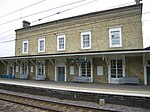Little Chesterford is a small village and civil parish in Uttlesford, Essex, in the East of England. Close to the Cambridgeshire border, it is built principally along a single sunken lane to the east of a chalk stream tributary of the River Cam or Granta and is located 1 km southeast of Great Chesterford and some 5 km northwest of Saffron Walden. The small hamlet of Springwell is just to the south of the village. Up the hill to the east is Chesterford Park, with a mid-19th-century mansion in a 250-acre (approx. 100 hectare) estate and now a science park called Chesterford Research Park. The wide and relatively deep valley of the river Cam provides a rolling landscape of chalky boulder clay with extensive and wide views. The surrounding farmland is mostly in intensive arable use and except for areas alongside the river, some of which is liable to flooding, is classified as being of grade 2 quality.The grouping of church, manor house and village hall form the heart of the village. The church of St Mary dates from the early 13th century and retains much of its original form, having a long aisleless nave and chancel under a single roof. The main furnishings of interest are the simple 15th century screen, the recently restored monument of James Walsingham (1728) – an early work by Henry Cheere – and the monumental brass to George and Isabel Langham (1462). The church was restored during the 19th century including the addition of a vestry and the building of a bell-cot for two bells at the west end.The manor also dates from the 13th century and is one of the earliest inhabited houses in Essex. It was built in three separate phases – a mid to late-13th century timber-framed aisled hall, flanked by a slightly later solar wing, and an earlier (early-13th century) and extremely rare stone survival in Essex that was converted into a services wing. It now has the form of a classic H-shaped manorial house and retains much of the original stone and woodwork.Amongst other buildings of interest, the former school was built in 1862 for 24 children, but was closed by 1902. The building (a typical example of a Victorian school) was used as the Sunday school and now serves as the village hall. Opposite is a 16th-century hall house, later floored, the cross-passage blocked by a fireplace but with the frame of the original front door exposed. There are more timber-framed and plastered houses up the village towards the Saffron Walden road. A small brick bridge over the Cam, built in 1791 to replace an earlier sixteenth century one, forms the village's western boundary.








